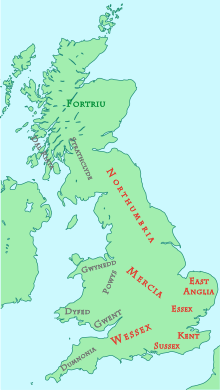Heptarchy
| History of England |
|---|
 |
|
|


Heptarchy (Greek: ἑπτά + ἀρχή seven + realm) is a collective name applied to the Anglo-Saxon ancient kingdoms of south, east, and central Great Britain during late antiquity and the early Middle Ages which eventually unified into Angle-land (England) (at this time the areas now known as Scotland and Wales were also divided into several smaller political units). The first recorded use of the term dates from 12th century in the English historian Henry of Huntingdon, and it has been in common use since the 16th century.
Use of the term
By convention the label is considered to cover the period from AD 500 to AD 850, approximately representing the period following the departure of Roman legions from Britain until the unification of the kingdoms under Egbert of Wessex.
The word heptarchy refers to the existence (as was thought) of seven kingdoms, which eventually merged to become the basis for the Kingdom of England; these were Northumbria, Mercia, East Anglia, Essex, Kent, Sussex and Wessex. The period supposedly lasted until the seven kingdoms began to consolidate into larger units, but the actual events marking this transition are debatable. At various times within the conventional period, certain rulers of Northumbria, Mercia and Wessex (such as Penda of Mercia) claimed hegemony over larger areas of England; yet as late as Edwy and Edgar, it was still possible to speak of separate kingdoms within the English population.
In reality the end of the Heptarchy was a gradual process. The 9th century Viking raids that led to the establishment of a Danish-controlled enclave at York, and ultimately to the Danelaw, gained considerable advantage from the petty rivalries between the old kingdoms. The need to unite against the common enemy was recognised, so that by the time Alfred of Wessex resisted the Danes in the late 9th century, he did so essentially as the leader of an Anglo-Saxon nation. Successive kings of Wessex (and especially Athelstan) progressively reinforced the English unitary state, until the old constituent kingdoms in effect became irrelevant.
Recent research has revealed that some of the Heptarchy kingdoms (notably Essex and Sussex) did not achieve the same status as the others. Conversely, there also existed alongside the seven kingdoms a number of other political divisions which played a more significant role than previously thought. Such were the kingdoms (or sub-kingdoms) of: Bernicia and Deira within Northumbria; Lindsey in present-day Lincolnshire; the Hwicce in the southwest Midlands; the Magonsæte or Magonset, a sub-kingdom of Mercia in what is now Herefordshire; the Wihtwara, a Jutish kingdom on the Isle of Wight, originally as important as the Cantwara of Kent; the Middle Angles, a group of tribes based around modern Leicestershire, later conquered by the Mercians; the Hæstingas (around the town of Hastings in Sussex); and the Gewissæ, a Saxon tribe in what is now southern Hampshire later developing into the kingdom of Wessex.
Certainly the term Heptarchy has been considered unsatisfactory since the early 20th century, and many professional historians no longer use it, feeling that it does not accurately describe the period to which it refers. However, it is still sometimes used as a label of convenience for a phase in the development of England.
Anglo-Saxon England heptarchy
The four main kingdoms in Anglo-Saxon England were:
- Wessex
- East Anglia
- Mercia
- Northumbria, including sub-kingdoms Bernicia and Deira
The other main kingdoms which were conquered by others entirely at some point in their history are:
Other minor kingdoms and territories
- Kingdom of Cornwall
- Isle of Wight, also known as the Wihtwara
- the Meonwara
- Surrey
- Kingdom of the Iclingas, a precursor state to Mercia
- Lindsey
- the Hwicce
- Magonsæte
- Pecsæte
- Wreocensæte
- Tomsæte
- Haestingas
- Middle Angles
References
This article needs additional citations for verification. (June 2007) |
- Monarchs of Britain, Encyclopædia Britannica
- Westermann Großer Atlas zur Weltgeschichte
See also
- History of Anglo-Saxon England
- Related terms : Bretwalda, High King for hegemons among Kings
- Compare : Tetrarchy
- Cornovii (Cornish)
External links
- The Burghal Hidage - Wessex's fortified burhs
Template:Start succession box |- style="text-align: center;" |- style="text-align:center;"
|style="width:30%;" rowspan="1"|Preceded by
| style="width: 40%; text-align: center;" rowspan="1"| The Heptarchy
circa 550–927
| style="width: 30%; text-align: center;" rowspan="1"| Succeeded by
|- |}
